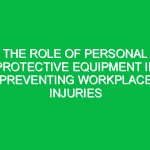Introduction
Creating a culture of Safety in the workplace is crucial for the well-being of employees and the success of any organization. A strong Safety culture not only reduces the risk of accidents and injuries but also boosts employee morale, productivity, and retention. In this article, we will explore practical steps to establish and maintain a culture of Safety in your workplace.
Understanding the Importance of Safety Culture
Before diving into the steps to create a culture of Safety, it’s essential to understand why it matters. A Safety culture is the shared values, beliefs, and attitudes towards Safety within an organization. When Safety is prioritized and ingrained in the company’s DNA, employees are more likely to follow Safety protocols, report hazards, and take proactive measures to prevent accidents.
Step 1: Leadership Commitment
One of the key pillars of a strong Safety culture is leadership commitment. Leaders must lead by example, prioritize Safety, and communicate the importance of Safety to all employees. When leaders demonstrate a genuine commitment to Safety, employees are more likely to follow suit.
Key Points:
– Engage with employees at all levels to promote Safety awareness.
– Provide resources and support for Safety initiatives.
– Recognize and reward Safety-conscious behavior.
Step 2: Employee Involvement
Empowering employees to participate in Safety initiatives is crucial for creating a culture of Safety. When employees feel valued and involved in Safety decisions, they are more likely to take ownership of Safety practices and hold themselves and their colleagues accountable.
Key Points:
– Encourage employees to report hazards and near misses.
– Involve employees in Safety committees and decision-making processes.
– Provide Safety training and resources for all employees.
Step 3: Communication and Training
Effective communication is essential for promoting a culture of Safety. Regularly communicate Safety policies, procedures, and expectations to all employees. Provide ongoing Safety training to ensure that employees are equipped with the knowledge and skills to work safely.
Key Points:
– Conduct regular Safety meetings and toolbox talks.
– Use multiple communication channels to reach all employees.
– Tailor training programs to specific job roles and hazards.
Step 4: Hazard Identification and Control
Identifying and controlling hazards is fundamental to maintaining a safe workplace. Encourage employees to report hazards, conduct regular inspections, and implement controls to mitigate risks. Continuously monitor and evaluate Safety performance to identify areas for improvement.
Key Points:
– Implement a hazard reporting system.
– Conduct regular Safety inspections and audits.
– Take prompt action to address identified hazards.
Step 5: Continuous Improvement
Creating a culture of Safety is an ongoing process that requires continuous improvement. Regularly review Safety performance, seek feedback from employees, and make adjustments to Safety programs as needed. Celebrate successes and learn from failures to drive continuous improvement.
Key Points:
– Establish Safety performance metrics and goals.
– Conduct regular Safety culture surveys.
– Implement a process for continuous feedback and improvement.
Conclusion
In conclusion, creating a culture of Safety in the workplace is a collective effort that requires commitment, communication, and continuous improvement. By prioritizing Safety, involving employees, and fostering a culture of accountability, organizations can create a safe and healthy work environment for all. Remember, Safety is everyone’s responsibility, and together, we can build a culture of Safety that protects and empowers employees.


